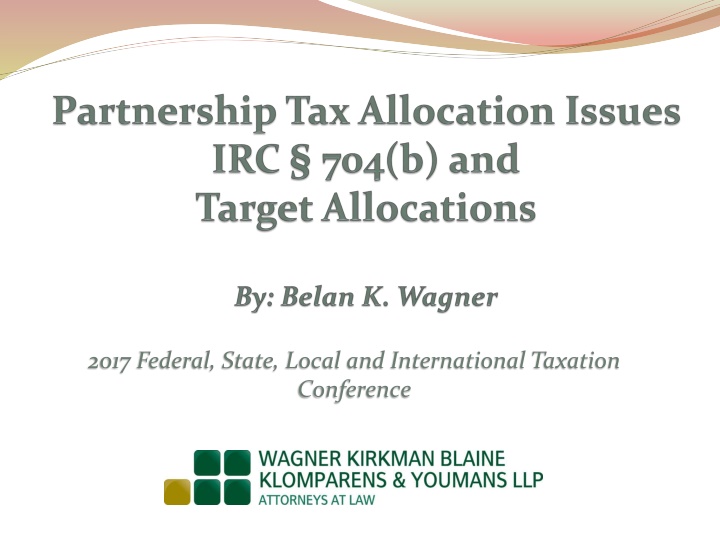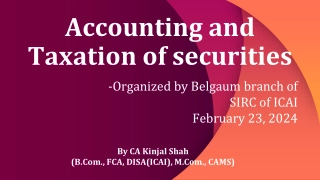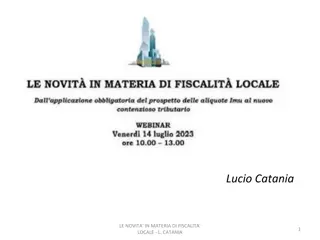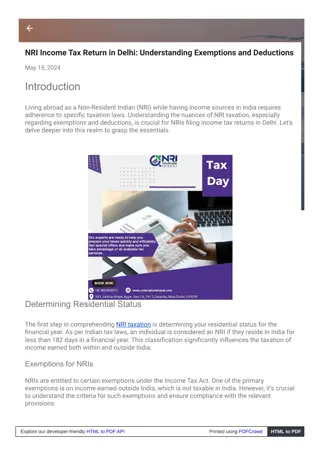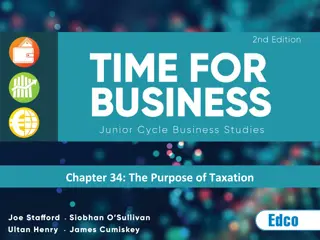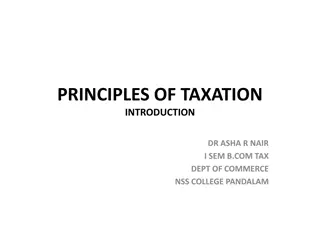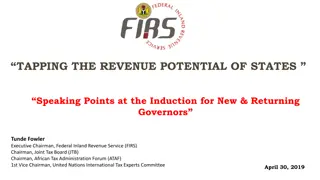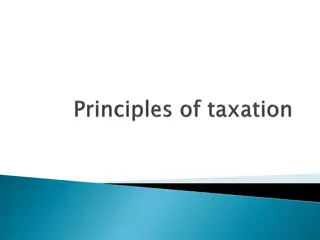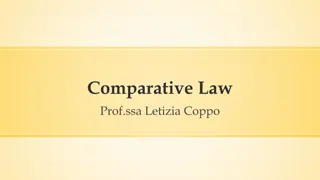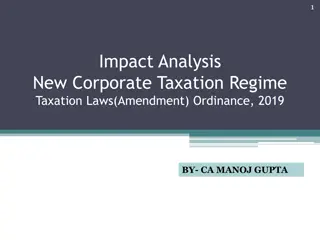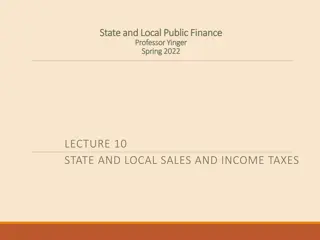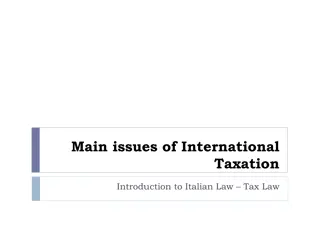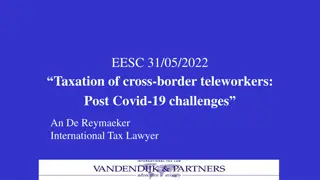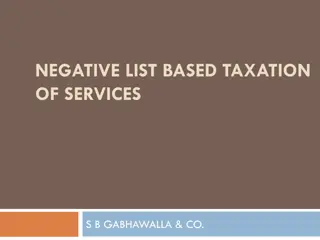2017 Federal, State, Local and International Taxation Conference
This conference focuses on advancements in federal, state, local, and international taxation. Join us to gain insights, network with experts, and stay updated on key tax trends and policies. Discover innovative tax strategies and best practices to optimize your tax planning and compliance processes. Engage in informative sessions and discussions covering a wide range of taxation topics. Don't miss this valuable opportunity to enhance your tax knowledge and meet fellow professionals in the field.
Download Presentation

Please find below an Image/Link to download the presentation.
The content on the website is provided AS IS for your information and personal use only. It may not be sold, licensed, or shared on other websites without obtaining consent from the author.If you encounter any issues during the download, it is possible that the publisher has removed the file from their server.
You are allowed to download the files provided on this website for personal or commercial use, subject to the condition that they are used lawfully. All files are the property of their respective owners.
The content on the website is provided AS IS for your information and personal use only. It may not be sold, licensed, or shared on other websites without obtaining consent from the author.
E N D
Presentation Transcript
2017 Federal, State, Local and International Taxation Conference
Background General Rule. IRC 704(b) generally prohibits allocations of income, gain, deduction, loss or credits between partners unless those allocations have "Substantial Economic Effect. Concept. The BASIC CONCEPT of 704(b) is that if there is an allocation of income, gain, deduction, loss or credit, it will have an economic consequence to the partners. WKBK&Y- November 17, 2017 2
Background Capital Account. That economic consequence is measured by the impact of the allocation on the Capital Account of the partners. Generally speaking, so long as an allocation of income, gain, deduction, loss or credit impacts the Capital Account and, therefore, determines how much a partner will receive upon liquidation, the allocation will be respected. WKBK&Y- November 17, 2017 3
Background Noncapital Account Partnerships. The Regulations under 704(b) acknowledge that all partnership agreements may not require the partners to maintain Capital Accounts in accordance with the regulations, and under such circumstances, the regulations under IRC 704(b) require that allocations be made "in accordance with a PARTNERS INTEREST IN THE PARTNERSHIP "( PIP ). WKBK&Y- November 17, 2017 4
Background Nonrecourse Deductions. The 704(b) regulations provide unique rules with respect to Nonrecourse Deductions because, by definition, the risk of loss falls on the creditor. The essential concept is that so long as the Nonrecourse Deductions impact the Capital Account of the partners and if the partners are required to "pay back" the tax benefit derived from the Nonrecourse Deductions upon disposition of Property (or earlier) then, the allocations of the Nonrecourse Deductions will be respected. WKBK&Y- November 17, 2017 5
Partnership/Operating Agreements Partnerships. The partnership agreement determines the rights and duties of the partners between themselves. Most states have two specific partnership acts, one relating to limited partnerships and the other relating to general partnerships. The limited partners normally do not have an obligation to contribute capital to the partnership even to pay off company debt. WKBK&Y- November 17, 2017 6
Partnership/Operating Agreements LLC. In a limited liability company the rights and duties of the members are determined under the "Operating Agreement." An LLC has the unique attribute that no "member" of the company must contribute capital to the company in the absence of an agreement to the contrary set forth in the "operating agreement." WKBK&Y- November 17, 2017 7
Deficit Capital Account Restoration Provisions Safe Harbor Requirement. To fall under a "safe harbor" for determining whether or not a special allocation has Substantial Economic Effect, the regulations generally require the inclusion of Deficit Capital Account Restoration Provision ("DRO") in the partnership or operating agreement or under State law. Sometimes professionals, not realizing the impact of the inclusion of a DRO in a limited partnership agreement or operating agreement, include such provisions for "tax purposes this is an error. WKBK&Y- November 17, 2017 8
Partner's Interest in Partnership (b)(3) Regs) Default Provision. Of essential importance to 704(b) is the concept of the PIP. This is a default provision. If a partnership agreement does not provide for allocation income, gain, deduction, loss or credit or if any such allocation is invalid, then the default is that the allocation will be made pursuant to the PIP of each partner. WKBK&Y- November 17, 2017 9
PIP Facts and Circumstances. The (b)(3) Regs generally provide for a facts and circumstance but list the following items as being particularly important: The partners relative contributions to the partnership; The interest of the partners and economic profits and losses (if different than in taxable income or loss); The interest of the partners and cash flow and other nonliquidating distributions; and The rights of the partners to distributions of capital upon liquidation. WKBK&Y- November 17, 2017 10
Preserved Value Rule The preserved value rule states that the fair market value of property is that the value of property as reflected on the books of the partnership, as adjusted for depreciation, is conclusively resumed to be the fair market value of the property. Reg. 1.704-1(b)(2)(iii)(c)(2) WKBK&Y- November 17, 2017 11
Example 1 G and H contribute $75,000 and $25,000, respectively, in forming an LLC. All income, gain, loss, and deduction will be allocated 50/50 between the partners and that the partners Capital Accounts will be maintained in accordance with the Regs. All partnership distributions will, regardless of Capital Account balances, be made 75% to G and 25% to H. There is no DRO. The allocations in the partnership agreement do not have "substantial" economic effect" because there is no DRO. Since contributions and distributions made are in a 75/25 ratio, partnership income, gain, loss, and deduction will be reallocated 75% to G and 25% to H under PIP. WKBK&Y- November 17, 2017 12
"Substantial Economic Effect"Regs (b)(2) A special allocation under a partnership agreement will be respected if the allocations has "Substantial Economic Effect." In order to satisfy the (b)(2) Regs., two tests must be satisfied: There must be a "economic effect" and it must be "substantial." Substantial Economic Effect must be tested annually. WKBK&Y- November 17, 2017 13
Economic Effect General Rule. In order for an allocation to have economic effect, it must first be consistent with the underlying partner s economic arrangement. This means that in the event there is an economic benefit or economic burden that corresponds to an allocation, the partner to whom the allocation is made must receive such economic benefit or bear such economic burden. WKBK&Y- November 17, 2017 14
Economic Effect Safe Harbor. In order to comply with the three basic requirements for economic effect safe harbor in Reg. 1.704-1(b)(2)(ii), the partnership agreement must provide, throughout the full term of the partnership, as follows: Capital Account Maintenance. The partners' Capital Accounts must be maintained in accordance with the rules of Treasury Regulation 1.704-1(b)(2)(iv), WKBK&Y- November 17, 2017 15
Economic Effect (Safe Harbor Continued) Capital Account Liquidation Distributions. Liquidating distributions are required to be made in accordance with the positive Capital Account balances of the partners, by the end of such taxable year (or, if later, within 90 days after the date of such liquidation), and WKBK&Y- November 17, 2017 16
Economic Effect (Safe Harbor Continued) Deficit Restoration Obligation (DRO). If a partner has a deficit balance in his Capital Account following the liquidation of his interest in the partnership, he must be unconditionally obligated to restore the amount of such deficit balance to the partnership by the end of such taxable year (or, if later, within 90 days after the date of such liquidation), which amount shall, upon liquidation of the partnership, be paid to creditors of the partnership or distributed to other partners in accordance with their positive Capital Account balances. WKBK&Y- November 17, 2017 17
Example 2 A and B form a general partnership with cash contributions of $40,000 each, which cash is used to purchase depreciable business property at a cost of $80,000. The partnership agreement provides that A and B will have equal shares of taxable income and loss (computed without regard to cost recovery deductions) and cash flow and that all cost recovery deductions on the property will be allocated to A. The agreement further provides that the partners Capital Accounts will be maintained in accordance with the regulations, but that upon liquidation of the partnership, distributions will be made equally between the partners (regardless of Capital Account balances) and no partner will be required to restore the deficit balance in his Capital Account for distribution to partners with positive Capital Account balances. WKBK&Y- November 17, 2017 18
Example 2 Continued In the partnership s first taxable year, it recognizes operating income equal to its operating expenses and has an additional $20,000 cost recovery deduction, which is allocated entirely to A. That A and B will be entitled to equal distributions on liquidation, even though A is allocated the entire $20,000 cost recovery deduction, indicates A will not bear the full risk of the economic loss corresponding to such deduction if such loss occurs. The allocation lacks economic effect and will be disregarded. The cost recovery deductions will be reallocated equally. WKBK&Y- November 17, 2017 19
Example 3 A and B each contribute $100 cash to the AB general partnership which purchases depreciable property (worth $500) for $200 cash and a $300 recourse note. The partnership is not required to pay principal on the note for three years. The partnership meets all of the safe harbor requirements for economic effect under the 704(b) regulations. Under the partnership agreement, all depreciation is allocated to A, and the remainder of the partnership income and loss is shared equally. WKBK&Y- November 17, 2017 20
Example 3 Continued During Year 1, the partnership has operating income of $180, operating expenses of $70, and depreciation of $100. To satisfy the Capital Account rules, the partners' Capital Accounts at the end of Year 1 will be as follows: WKBK&Y- November 17, 2017 21
Example 3 Continued Capital Accounts A B Initial balance $100 $100 Operating income 90 90 Less: Operating expenses (35) (35) Depreciation (100) ____ Balance at end of Year 1 $ 55 $155 WKBK&Y- November 17, 2017 22
Example 3 Continued The economic effect of allocating the Year 1 depreciation to A can be shown by assuming a hypothetical sale of the partnership's property for an amount equal to its book value($400) at the beginning of Year 2. Since the partnership would recognize no gain or loss on the sale, the partners' Capital Accounts would remain unchanged. After payment of the debt, the partnership would have cash of $210 ($400 sale proceeds plus $110 of cash flow from Year 1 less $300 debt repayment) available for distribution. Accordingly, each partner would be entitled to a distribution of cash equal to her Capital Account balance ($55 to A and $155 to B). The Capital Account rules force A to bear the economic burden of $100 of depreciation by reducing his share of the proceeds on liquidation. WKBK&Y- November 17, 2017 23
Alternate Test for Economic Effect: Qualified Income Offsets (QIO) General Rule. If a partnership agreement provides for Capital Account Maintenance and Capital Account Liquidation Distributions but does not contain a DRO, the Regs. provide that the Economic Effect Test will still be satisfied if the partnership agreement has a Qualified Income Offset ( QIO ) provision. WKBK&Y- November 17, 2017 24
Alternate Test for Economic Effect: Qualified Income Offsets (QIO) In other words, a QIO acts as a substitute for a DRO, but there is a big limitation. The allocation cannot cause or increase a deficit balance in such partners capital account (in excess of any limited DRO). WKBK&Y- November 17, 2017 25
Alternate Test for Economic Effect: Qualified Income Offsets (QIO) What is a QIO? A QIO is a provision in the partnership agreement which provides an adjustment that a partner who unexpectedly receives an allocation, or distribution described in regulation section 1.704-1(B)(2)(II)(D)(4), 1.704- 1(B)(2)(II)(D)(5) and 1.704-1(B)(2)(II)(D)(6) (herein the (D)(4)-(D)(6)) adjustments, will be allocated items of income and gain (consisting of a pro rata portion of each item of partnership income, including gross income, and gain for such year)in an amount and manner sufficient to eliminate such deficit balance as quickly as possible. WKBK&Y- November 17, 2017 26
Alternate Test for Economic Effect: Qualified Income Offsets (QIO) Section d(4) - d(6) Adjustments. The d(4) - d(6) Adjustments are special adjustments to the Capital Account of each partner which are required to be made to their Capital Accounts in order to determine if an allocation will reduce such partner s Capital Account to zero. Remember that if a partnership agreement does not have a DRO, then a QIO can act as a substitute; BUT an allocation will only have Economic Effect under a QIO to the extent that the partner has a positive balance in his Capital Account. WKBK&Y- November 17, 2017 27
Example 4 A and B form a general partnership with cash contributions of $40,000 each which cash is used to purchase depreciable business property at a cost of $80,000. Under the Partnership Agreement, all income and loss except depreciation is allocated equally. All depreciation is allocated to A. The Partnership Agreement includes a Capital Account Maintenance provision and a Capital Account Liquidation Distribution provision, but no DRO provision. The Partnership Agreement includes a QIO provision. Assume that in the first year, the depreciation deduction is $20,000 and that no d(4) - d(6) adjustments are required. WKBK&Y- November 17, 2017 28
Example 4 Continued A B Capital account upon formation $40,000 $40,000 Less: year 1 cost recovery deduction (20,000) 0 Capital account at end of year 1 $20,000 $40,000 Under the alternate economic effect test ( QIO ), the allocation of the $20,000 cost recovery deduction to A has economic effect. WKBK&Y- November 17, 2017 29
Example 5 Assume the same facts as above in Example 4 but that in the partnership s second taxable year, it recognizes operating income equal to its operating expenses and has a $25,000 cost recovery deduction which, under the partnership agreement, is allocated entirely to A. A B Capital account at beginning of year 2 $20,000 $40,000 Less: year 2 cost recovery deduction (25,000) 0 Capital account at end of year 2 ($5,000) $40,000 WKBK&Y- November 17, 2017 30
Example 5 Continued The allocation of the $25,000 cost recovery deduction to A satisfies the alternate economic effect test only to the extent of $20,000. Therefore, only $20,000 of such allocation has economic effect, and the remaining $5,000 must be reallocated in accordance with the partners interests in the partnership. WKBK&Y- November 17, 2017 31
Substantiality General Rule. The economic effect of an allocation (or allocations) is substantial if there is a reasonable possibility that the allocation (or allocations) will affect substantially the dollar amounts to be received by the partners from the partnership, independent of tax consequences. Beware of transitory and shifting allocations. WKBK&Y- November 17, 2017 32
Nonrecourse Liabilities and Deductions Introduction. Treasury Regulation Section 1.704-2 establishes rules with respect to allocations attributable to nonrecourse liabilities and Nonrecourse Deductions . WKBK&Y- November 17, 2017 33
Nonrecourse Liabilities and Deductions Safe Harbor/PIP. Because Nonrecourse Deductions lack economic effect, they must be allocated in accordance with the more general facts and circumstances test, namely, the partners' interests in the partnership. Unless the safe harbor applies. The safe harbor test eventually requires a MGCB ( Minimum Gain Chargeback ) provision on lieu of a DRO. WKBK&Y- November 17, 2017 34
Minimum Gain Introduction. Under the Crane and the Tufts cases, to the extent a nonrecourse liability exceeds the adjusted tax basis of the partnership property it encumbers, a disposition of that property will generate gain that at least equals that excess amount. Under 704(b) this amount is determined by reference to Adjusted Book Value as opposed to Adjusted Tax Basis (and is referred to as Partnership Minimum Gain). What s important to note is that Partnership Minimum Gain changes as the debt diminishes or increases, and as deductions and losses attributable to nonrecourse debt arise. WKBK&Y- November 17, 2017 35
Minimum Gain Calculating Minimum Gain. The amount of Partnership Minimum Gain is determined by first computing for each partnership nonrecourse liability any gain the partnership would realize if it disposed of the property subject to that liability for no consideration other than full satisfaction of the liability, and then aggregating the separately computed gains. WKBK&Y- November 17, 2017 36
Minimum Gain The amount of Partnership Minimum Gain also includes minimum gain arising from a conversion, refinancing, or other change to a debt instrument, but only to the extent a partner is allocated a share of that minimum gain. WKBK&Y- November 17, 2017 37
Minimum Gain For any partnership taxable year, the net increase or decrease in Partnership Minimum Gain is determined by comparing the Partnership Minimum Gain on the last day of the immediately preceding taxable year with the Partnership Minimum Gain on the last day of the current taxable year. WKBK&Y- November 17, 2017 38
Minimum Gain Chargebacks Definition. A Minimum Gain Chargeback is a gain that is allocated to a partner or partners based upon or attributable to a decrease in Partnership Minimum Gain. As such, like Nonrecourse Deductions, a Minimum Gain Chargeback, cannot have economic effect because the gain merely offsets Nonrecourse Deductions previously claimed by the partnership. WKBK&Y- November 17, 2017 39
Minimum Gain Chargebacks Allocation to Partners. The regulations provide that to avoid impairing the economic effect of other allocations, allocations pursuant to a Minimum Gain Chargeback must be made to the partners that either were allocated Nonrecourse Deductions or received distributions of proceeds attributable to a nonrecourse borrowing. WKBK&Y- November 17, 2017 40
Minimum Gain Chargebacks Effect of Minimum Gain Chargeback. As regards the Minimum Gain Chargeback requirement, if there is a net decrease in partnership minimum gain for a partnership taxable year, the minimum gain chargeback requirement applies and each partner must be allocated items of partnership income and gain for that year equal to that partner s share of the net decrease in partnership minimum gain. WKBK&Y- November 17, 2017 41
Minimum Gain Chargebacks Any Minimum Gain Chargeback required for a partnership taxable year consists first of certain gains recognized from the disposition of partnership property subject to one or more partnership nonrecourse liabilities and then if necessary consists of a pro rata portion of the partnership's other items of income and gain for that year. If the amount of the Minimum Gain Chargeback requirement exceeds the partnership's income and gains for the taxable year, the excess carries over. WKBK&Y- November 17, 2017 42
Minimum Gain Chargebacks Exception to Minimum Gain Chargeback. An exception applies to the Minimum Gain Chargeback requirement to the extent the partner contributes capital to the partnership that is used to repay the nonrecourse liability or is used to increate the basis of the property subject to the nonrecourse liability. WKBK&Y- November 17, 2017 43
Example 6 A (the general partner) contributes no capital and B (the limited partner) contributes $200,000 cash to the AB partnership which purchases a building (worth $1,000,000) for $200,000 cash and an $800,000 nonrecourse note. The partnership agreement satisfies the requirements of the alternate economic effect test ( QIO ) and contains a Minimum Gain Chargeback provision. WKBK&Y- November 17, 2017 44
Example 6 Continued BOY Year 1 Assets Building $1,000,0000 Capital and Liabilities Nonrecourse Debt $800,000 A -0- B $200,000 WKBK&Y- November 17, 2017 45
Example 6 Continued Only A is required to restore any deficit in his Capital Account under state law. During Years 1-3, the partnership has annual operating income of $150,000, annual operating expenses of $130,000, and annual depreciation deductions of $200,000. The partnership uses its annual cash flow of $20,000 to repay a portion of the loan principal at the end of each year. The partnership does not intend to make any distributions before liquidation. WKBK&Y- November 17, 2017 46
Example 6 Continued In Year 1, the entire depreciation is allocated to B, and the net operating income of $20,000 is allocated equally to A and B. The Year 1 allocations have economic effect, leaving each of the partners with a positive Capital Account balance ($10,000) at year end. There are no nonrecourse deductions in Year 1 because at year end the basis of the property ($800,000) exceeds the amount of the debt ($780,000.) WKBK&Y- November 17, 2017 47
Example 6 Continued EOY Year 1 Assets Building $800,000 Liability and Equity Nonrecourse Debt $780,000 A $10,000 B $10,000 WKBK&Y- November 17, 2017 48
Example 6 Continued At the end of Year 2, there is partnership minimum gain of $160,000 ($760,000 debt less $600,000 basis). Accordingly, the $200,000 depreciation deduction comprises $40,000 of recourse deductions and $160,000 of nonrecourse deductions. Without regard to the nonrecourse deductions, the partnership has a taxable loss of $20,000 for Year 2 ($150,000 operating income less $130,000 operating expenses less $40,000 depreciation) Allocation of the $20,000 loss equally to A and B has economic effect, and reduces each partner's Capital Account to zero. WKBK&Y- November 17, 2017 49
Example 6 Continued The $160,000 of nonrecourse deductions for Year 2 may be allocated in any manner that is "reasonably consistent" with valid allocations of other significant items attributable to the underlying property. A 50/50 allocation, for example, would correspond to the partners' equal division of other significant items that have economic effect. Can the entire nonrecourse deduction be allocated to B, on the ground that it corresponds to the allocation to B of the entire Year 1 depreciation (consisting of $200,000 or recourse deductions attributable to B's investment in the property)? If the allocation of Year 1 deprecation represents a "significant item," then an allocation of the entire nonrecourse deduction to B should be respected. WKBK&Y- November 17, 2017 50
